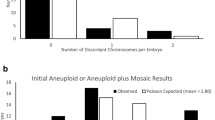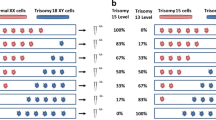Abstract
Objective
The objective of this study is to determine mosaicism and its effect on blastocysts; abnormal blastocysts determined by molecular testing were sequentially biopsied and retested.
Material and method
We re-biopsied 37 blastocyst-stage abnormal embryos from eight patients, which were reanalyzed to determine the level of concordance between biopsies and inter-laboratory congruence between reputable commercial PGS laboratories.
Results
The main outcome measures were intra-embryo variation between sequential embryo biopsies and inter-laboratory variation between two PGS laboratories. The compatibility between both aCGH and NGS was found to be 11 % (3/27). Importantly, 9/27 (33 %) of embryos originally reported to be aneuploid, upon repeat assessment, were found to be euploid. The concurrence for SNP array and NGS was 50 % (3/6), and 17 % (1/6) of these abnormal embryos tested normal upon re-evaluation with NGS. NGS resulted 41 % (11/27) normal results when 27 of CGH abnormal embryos were retested. Concordance between aCGH and NGS was 4 % (1/27) whereas in three instances, gender discrepancy was observed with NGS when aCGH abnormal embryos were reanalyzed.
Conclusions
The results of these studies reinforce the prevalence of inconsistencies during PGS evaluation of trophectoderm biopsies possibly due to variations in platform sensitivity and heightening concerns over the clinical tractability of such technology in human ARTs..
Similar content being viewed by others
References
Mastenbroek S, Twisk M, van Echten-Arends J, Sikkema-Raddatz B, Korevaar JC, Verhoeve HR, et al. In vitro fertilization with preimplantation genetic screening. N Engl J Med. 2007;357:9–17.
Gleicher N, Kushnir VA, Barad DH. Preimplantation genetic screening (PGS) still in search of a clinical application: a systematic review. Reprod Biol Endocrinol. 2014;12:22.
Barzrgar M, Gourabi H, Valojerdi MR, Yazdi PE, Baharvand H. Self-correction of chromosomal abnormalities in human preimplantation embryos and embryonic stem cells. Stem Cells Dev. 2013;22:2449–56.
Kalousek DK, Dill FJ. Chromosomal mosaicism confined to the placenta in human conceptions. Science. 1983;221:665–7.
Wells D, Sherlock JK, Handyside AH, Delhanty JD. Detailed chromosomal and molecular genetic analysis of single cells by whole genome amplification and comparative genomic hybridisation. Nucleic Acids Res. 1999;27(4):1214–8.
Munné S, Wells D, Cohen J. Technology requirements for preimplantation genetic diagnosis to improve assisted reproduction outcomes. Fertil Steril. 2010;94:408–30.
Evans MI, Wright DA, Pergament E, Cuckle HS, Nicolaides KH. Digital PCR for noninvasive detection of aneuploidy: power analysis equations for feasibility. Fetal Diagn Ther. 2012;31(4):244–7.
Treff NR, Levy B, Su J, Northrop LE, Tao X, Scott Jr RT. SNP microarray-based 24 chromosome aneuploidy screening is significantly more consistent than FISH. Mol Hum Reprod. 2010;16(8):583–9.
Werner MD, Scott Jr RT, Treff NR. 24-chromosome PCR for aneuploidy screening. Curr Opin Obstet Gynecol. 2015;27(3):201–5.
Yan L, Huang L, Xu L, Huang J, Ma F, Zhu X, et al. Live births after simultaneous avoidance of monogenic diseases and chromosome abnormality by next-generation sequencing with linkage analyses. Proc Natl Acad Sci U S A. 2015;112(52):15964–9.
Esfandiari N, Bentov Y, Casper RF. Trophectoderm biopsy for aneuploidy screening using different platforms and conflicting test results. Abstract O-034, Annual Meeting of ESHRE, Munich June 27- July 2, 2014.
Tiegs AW, Hodes-Wertz B, McCulloh DH, Grifo J. Clinical error rate of array comparative genomic hybridization (ACGH) in euploid blastocysts. Fertil Steril. 2015;104 Suppl 3:e275.
Greco E, Minasi G, Fiorentino F. Healthy babies after intrauterine transfer of mosaic aneuploid blastocysts. N Engl J Med. 2015;373:2089–90.
Gleicher N, Vidali A, Braverman J, Kushnir VA, Albertini DF, Barad DH. Further evidence against use of PGS in poor prognosis patients: report of normal births after transfer of embryos reported as aneuploid. Fertil Steril. 2015;104 Suppl 3:e9.
Conlin LK, Thiel BD, Bonnemann CG, Medne L, Ernst LM, Zackai EH, et al. Mechanisms of mosaicism, chimerism and uniparental disomy identified by single nucleotide polymorphism array analysis. Hum Mol Genet. 2010;19:1263–75.
Mastenbroek S, Repping S. Preimplantation genetic screening: back to the future. Hum Reprod. 2014;29:1846–50.
Keskintepe L, Sher G, Machnicka A, Tortoriello D, Bayrak A, Fisch J, et al. Vitrification of human embryos subjected to blastomere biopsy for pre-implantation genetic screening produces higher survival and pregnancy rates than slow freezing. J Assist Reprod Genet. 2009;26(11–12):629–35.
Vanneste E, Voet T, Le Caignec C, Ampe M, Konings P, Melotte C, et al. Chromosome instability is common in human cleavage-stage embryos. Nat Med. 2009;15(5):577–83.
King RW. When 2+2=5: the origins and fates of aneuploid and tetraploid cells. Biochim Biophys Acta. 2008;1786(1):4–14.
Fiorentino F, Bono S, Biricik A, Nuccitelli A, Cotroneo E, Cottone G, et al. Application of next-generation sequencing technology for comprehensive aneuploidy screening of blastocysts in clinical preimplantation genetic screening cycles. Hum Reprod. 2014;29(12):2802–13.
Treff NR, Fedick A, Tao X, Devkota B, Taylor D, Scott Jr RT. Evaluation of targeted next-generation sequencing-based preimplantation genetic diagnosis of monogenic disease. Fertil Steril. 2013;99(5):1377–84.
Baart EB, Martini E, van den Berg I, Macklon NS, Galjaard RJ, Fauser BC, et al. Preimplantation genetic screening reveals a high incidence of aneuploidy and mosaicism in embryos from young women undergoing IVF. Hum Reprod. 2006;21(1):223–33.
Vanneste E, Voet T, Melotte C, Debrock S, Sermon K, Staessen C, et al. What next for preimplantation genetic screening? High mitotic chromosome instability rate provides the biological basis for the low success rate. Hum Reprod. 2009;24(11):2679–82.
McCoy RC, Demko ZP, Ryan A, Banjevic M, Hill M, Sigurjonsson S, et al. Evidence of selection against complex mitotic-origin aneuploidy during preimplantation development. PLoS Genet. 2015;22:11(10).
Sandalinas M, Sadowy S, Alikani M, Calderon G, Cohen J, Munné S. Developmental ability of chromosomally abnormal human embryos to develop to the blastocyst stage. Hum Reprod. 2001;16(9):1954–8.
Schoolcraft WB, Katz-Jaffe MG, Stevens J, Rawlins M, Munne S. Preimplantation aneuploidy testing for infertile patients of advanced maternal age: a randomized prospective trial. Fertil Steril. 2009;92(1):157–62.
Johnson DS, Gemelos G, Baner J, Ryan A, Cinnioglu C, Banjevic M, et al. Preclinical validation of a microarray method for full molecular karyotyping of blastomeres in a 24-h protocol. Hum Reprod. 2010;25(4):1066–75.
Capalbo A, Wright G, Elliott T, Ubaldi FM, Rienzi L, Nagy ZP. FISH reanalysis of inner cell mass and trophectoderm samples of previously array-CGH screened blastocysts shows high accuracy of diagnosis and no major diagnostic impact of mosaicism at the blastocyst stage. Hum Reprod. 2013;28(8):2298–307.
Fragouli E, Alfarawati S, Spath K, Tarozzi N, Borini A, Wells D. The developmental potential of mosaic embryos. Fertil Steril. 2015;104 Suppl 3, e96.
Orvieto R, Shuly Y, Brengauz M, Feldman B. Should pre-implantation genetic screening be implemented to routine clinical practice? Gynecol Endocrinol. 2016;12:1–3.
Author information
Authors and Affiliations
Corresponding author
Additional information
Capsule
Blastocyst mosaicism were evaluated for the consistency of preimplantation genetic screening procedures.
Rights and permissions
About this article
Cite this article
Tortoriello, D.V., Dayal, M., Beyhan, Z. et al. Reanalysis of human blastocysts with different molecular genetic screening platforms reveals significant discordance in ploidy status. J Assist Reprod Genet 33, 1467–1471 (2016). https://doi.org/10.1007/s10815-016-0766-5
Received:
Accepted:
Published:
Issue Date:
DOI: https://doi.org/10.1007/s10815-016-0766-5




